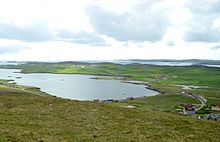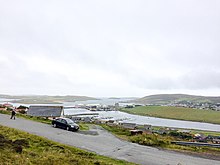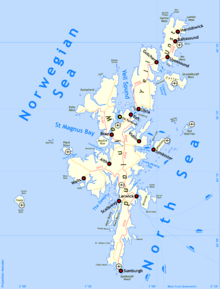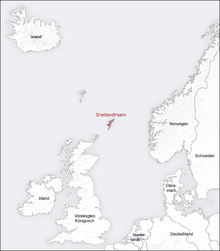Shetland
![]()
This article explains the archipelago belonging to Scotland; for the sub-Antarctic archipelago, see Southern Shetland Islands; for other meanings, see Shetland (disambiguation).
![]()
Hjaltland is a redirect to this article. For the ferry, see Hjaltland (ship).
Shetland [ˈʃɛtlənd], also mod. English Shetland Islands or Shetlands for short, German often Shetlandinseln, are a group of islands belonging to Scotland in the North Sea and North Atlantic between Norway, Scotland/Orkney and the Faroe Islands. Some linguists see a connection with Inse Cat ("island" of the Cattes or Chattes), mentioned in Old Irish texts, but it is otherwise unidentifiable. Excluding the outlying islands of Fair Isle and Foula, they cover an area 80 km by 120 km between latitudes 59 and 61 and form the northernmost part of the United Kingdom. Of the 1466 km² area, the main island Mainland accounts for about two thirds. The administrative centre and largest city of Shetland is Lerwick on Mainland. The historical capital and second largest settlement is Scalloway. The highest elevation of the Shetland Islands is Ronas Hill on Mainland with 449 m above sea level.

The south of Mainland near Lerwick
History
Previous story
Shetland has been inhabited since the 3rd millennium BC. The inhabitants practiced agriculture and animal husbandry and built stone tombs (e.g. Gillaburn, Islesburgh Cairn, Ronas Hill, Punds Water or Vementry).
In the 2nd millennium BC (Bronze Age) the climate became wetter and colder, so the inhabitants settled closer to the coast. In the Iron Age, brochs, round stone towers that can still be visited today were built here: for example Clickhimin, the Broch of Culswick, the Jarlshof and Broch of Mousa, but also blockhouses, ring forts, rampart forts, earthhouses souterrains and wheelhouses or temples such as Stanydale characterise the image of the archipelago.
What language was spoken on the islands until the arrival of the Vikings is largely unclear. It may have been Pictish, a now extinct - probably Celtic - language. In the 9th century, this language was supplanted by Old Norse, spoken by the Scandinavian immigrants, which evolved into the Norse dialect of Norn in Shetland. Norn was spoken in the islands until the 18th century, with its extinction it was replaced as the vernacular by Scots. However, the influence of Norn is still noticeable in a number of grammatical peculiarities (such as the formation of tenses with "ta be" instead of "tae hae" = "I am been" instead of "I hae been" or "I wis been" instead of "I haed been") and a large number of words borrowed from Norn. This makes the Shetland island dialect a distinctive variety of Scottish English, or more precisely "North Insular Scots".
Antiquity to the present
The Skoten, whose raids are reported by the Romans, originally came from Ireland. At the time of the kingdom of Dalriada they extended from County Antrim in Northern Ireland to Argyll in Western Scotland. In the rest of Scotland and the Northern Isles lived the Picts ("the Painted Ones") first mentioned in Roman accounts in 297 AD. In the 9th century, the Vikings landed here and named the islands Hjaltland. They established new laws of their own and, above all, their own language, which developed into Norn. In the 10th century they were Christianized. Around 1195, the islands were placed directly under the crown of Norway for some time. The Shetlands also belonged to Norway later on. In the 14th century Norway (with its possessions) united with Sweden and Denmark. The hoard on St Ninian's Isle dates from the Viking Age.
The Norwegian-Danish crown estate in the Shetland Islands, i.e. the land in question and the rights accruing from the land, came under the control of Scotland as security for the dowry of the daughter of the Danish King Christian I, Margaret, in 1469, when she married King James III of Scotland. Shetland was subsequently annexed by the Kingdom of Scotland but, unlike Orkney, was not immediately incorporated into the general administration of the realm but was placed under the Royal Scottish Privy Council. From then on, Scottish influence over the islands grew. Old Norn as a commonly spoken language died out in the 19th century. Nevertheless, to this day, especially on the northernmost island of Unst, there are still a few old people who remember the old sagas and stories.
From the 15th to the end of the 17th century, lively trade relations developed between the Hanseatic League and Shetland, which required numerous imported goods.
During the Second World War, Shetland played a role in supporting the Norwegian resistance and escaping from occupied Norway. Commando operations were carried out and agents smuggled in from here. Crossing between Shetland and the entire Norwegian coast was accomplished with mainly Norwegian fishing boats, which was only possible during the winter season. The actions became known as the "Shetland Bus", of which the most famous were probably the attacks on the German battleship Tirpitz in 1942 and on the heavy water plant of Norsk Hydro at Rjukan in the Norwegian Telemark.

Map showing the presumed location and extent of Doggerland around the time of 8000 BC on the territory of present-day Europe with additional representation of the land areas at that time in present-day Viking (sea area) and around the Shetland Islands.
.jpg)
Shetlands (NASA Landsat Project)

Landscape around Scalloway, Mainland, in Shetland

Overview: The archipelago

Overview: Location of the Shetland Islands (red)
Earth Sciences
Geology and morphology
The archipelago was formed at the beginning of the Paleozoic era during the Caledonian mountain building. It is composed of different sedimentary rocks. Shetland's surface is rocky. The archipelago is also called "The old rock" because it is dominated by hard sediments that are among the oldest rocks on earth. Shetland-Mainland, Yell and the west of Unst are composed of crystalline shales and gneisses. North Mainland is composed mainly of granite. Gabbro and serpentine form the east of Unst and Fetlar. Sandstone is found only on the western and eastern edges of the archipelago. The glaciers of the ice age are responsible for the relief there. The landscape here resembles that of Orkney, while the rest of Shetland is rugged. The soil layer is thin, boulders, bogs and acid meadows, numerous small lakes and ponds are present. The hard rocks of Mainland offered enormous resistance to the ice masses. These followed the weak zones in the earth's crust, the fold and fracture lines from the time of mountain building or the valleys filled with limestone deposits. Thus were formed the mighty glacial valleys and the long and deep Voes: Bowland, Clousta, Culbinsbourgh, Footabrough, Leiraness, Papil, Quarf, Scalloway, Scatsta, Setter, Snarraness, Sound, Sullom and Tresta. Picturesque shapes that characterise the west-facing coastal panorama were created by the interaction of westerly winds and surf that undermined the rocks. Gloups developed as holes broke into the too-thin cover of sea caves. Crevices cutting into the land widened into what are known as geos.
The Geos and Gloups and the rock gate of Dore Holm off the west coast of Esha Ness offer the most impressive sight in the north-west of Mainland. The Catpund-burn, with steatite, serpentinite and shale layers, runs eastwards into the sea at Cunningdburgh for about a kilometre.
Climate
Shetland is generally very mild and humid (1000 mm rainfall annually), determined by the Gulf Stream. Winter on the islands is usually quite mild with only occasional frost and rather rare snowfall, although the winter half-year is also the wettest time of the year. In summer, temperatures can easily rise to 15 °C or more. However, storms, heavy rain and fog are common and can make the weather relatively uncomfortable even in summer.
Climate table Lerwick
| Month | Jan | Feb | Mar | Apr | May | Jun | Jul | Aug | Sep | Oct | Nov | Dec | Year |
| Day temperature °C | 4 | 4 | 6 | 9 | 12 | 13 | 15 | 15 | 12 | 10 | 7 | 5 | 9,3 |
| Night temperature °C | 1 | 0 | 1 | 3 | 5 | 7 | 9 | 9 | 7 | 5 | 2 | 1 | 4,1 |
| Sunshine hours per day | 1 | 2 | 3 | 4 | 5 | 6 | 6 | 5 | 4 | 2 | 1 | 0 | 3,2 |
| Rainy days | 22 | 19 | 16 | 15 | 14 | 15 | 16 | 17 | 18 | 20 | 23 | 21 | 216 |
| Water temperature °C | 5 | 5 | 5 | 6 | 7 | 9 | 11 | 12 | 11 | 10 | 8 | 6 | 8 |
-GB.png)
Climate diagram of Lerwick
.jpg)
Dore Holm
Questions and Answers
Q: What is Shetland?
A: Shetland is an archipelago, the furthest out part of Scotland in the United Kingdom.
Q: Where is Shetland located?
A: Shetland is located between the Faroe Islands and the Orkney Islands, about 50 miles to the northeast of the Orkney Islands.
Q: How many islands are there in the Shetland group?
A: There are about 100 islands in the Shetland group.
Q: How many islands in the Shetland group are inhabited by people?
A: People live on 16 of the islands in the Shetland group.
Q: What is the climate like in the Shetland group?
A: The climate of the Shetland group is subarctic and rather bleak.
Q: What is the administrative center of Shetland?
A: The administrative center of Shetland is Lerwick.
Q: What are some well-known exports from Shetland?
A: Some well-known exports from Shetland are the Shetland ponies, Shetland Sheepdog, and sheep known for their fine wool.
Search within the encyclopedia